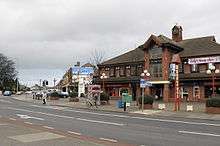Killester
Killester (Irish: Cill Easra) is a small, largely residential, suburb of Dublin, Ireland on the Northside of the city.

Killester is also a civil parish in the ancient barony of Coolock.[1]
Location and access
Killester is located between Clontarf, Donnycarney, Raheny and Artane, and it falls within the postal districts of Dublin 3 and 5. St. Anne's Park lies just beyond Killester on the Raheny/Clontarf side. The area lies either side of the Howth Road, as far as the Malahide Road, and is also reached by Collins Avenue (East).
It has a rail station on the DART line (also on the Dublin-Belfast line but with no stopping of inter-city trains), and Dublin Bus routes 29A, 31, 32A/B and 42A from the city centre go through the area. The original Killester railway station opened on 1 October 1845[2] but closed after two years, re-opening on a new site about 200 m (656 ft) further north in 1923.
Killester lies within the Clontarf/Dublin Bay North electoral district.
History and religion
Killester has been noted in city and church records going back many centuries, with variant spellings such as "killtrsta" (St. Laurence O'Toole) and "Kylestre", and was the site of both an early church and a convent or monastery. The name probably means "Church of (St.) Stra". The ruins of a religious building can still be seen, and nearby there is a modern convent, with a school.
The manor of Killester was given to one Adrian le Brun in the twelfth century. In the seventeenth century it was owned by the White family, from whom it passed by inheritance to the St Lawrence family, Barons and later Earls of Howth. In the seventeenth century it went to the Cootes, a branch of the family of the Earls of Mountrath.
Today there is a Roman Catholic Parish of Killester. The current Roman Catholic church, on the Howth Road, opposite St. Brigid's National School, began construction in 1924, and was consecrated in 1926. For many years, it was Parish Church for the combined parish of Killester and Raheny. It was extended in 1952, and a new Resource Centre was built alongside in the 2000s. Notably, the church held a reputed relic of St. Brigid, one of Ireland's three Patron Saints; a fragment of her skull was brought from Portugal in 1928; the relic was stolen. Alongside the church is a parish resource centre, opened in autumn 2004, with multiple rooms and a coffee shop overlooking the church's peace garden.
The old Parish of Killester in the Church of Ireland (the Parish of St. Brigid) was merged with Clontarf Parish in 1686 (church located on Seafield Road), and the combined entity still serves the Anglican communities of both areas. A new parish centre was built beside the parish church in the 2000s, to serve the needs of parishioners and, as capacity allows, the wider community of all faiths.
Killester is perhaps best known for its association with World War I veterans who were settled there in planned development from late 1922 onwards. Much of the personal and social history of this phase in Killester's development over the last century is recorded and discussed online at a Facebook page[3], where pictures and historical anecdotes are documented.
Amenities
Killester has a shopping plaza with a range of shops including a SuperValu supermarket, pharmacies, a service station, cafes and a pub. It is the site of a third-level institution, Killester College of Further Education, formerly known as St. Peter's College. The primary schools in the area are St Brigids girls national school, St Brigids boys national school. Secondary schools include St Mary’s, St Paul’s and many children in the area also attend Holy Faith Clontarf, Manor House, St David’s, Belvedere and the institute of education.
Residents
- Brian Fenton, Gaelic footballer who bought a house in Killester[4]
References
- Placenames Database of Ireland - Killester civil parish
- "Killester station" (PDF). Railscot - Irish Railways. Retrieved 2007-09-03.
- https://www.facebook.com/killesterhistory
- Keys, Colm (28 September 2019). "Maintaining standards over a long period is now my big motivator". Irish Independent. Independent News & Media. Retrieved 28 September 2019.
- Garrett, Arthur; 2006 (new edition), Killester, Dublin: History of Killester Parish